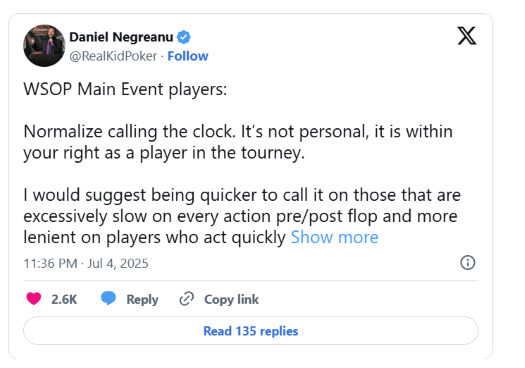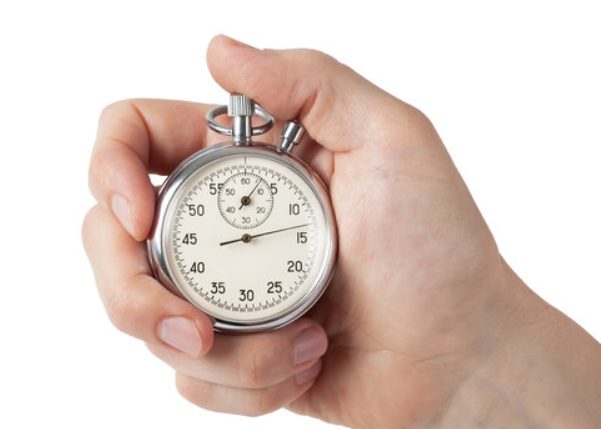A bit of a controversy blew up at the WSOP Main Event this week about when to call the clock. Last week Daniel Negreanu took to social media to declare:

Anyone who plays live poker knows how irritating it can be to play with an opponent who takes 40 seconds before every action. We get it. You’re hiding your hand strength. Now get on with it. Of course, that 40 seconds is too short to call a clock on this player. How long does that 40 seconds have to stretch before you feel justified calling the clock?
The Kassouf Factor
Several days after Negreanu posted the above, 2016 Main Event menace Will Kassouf raised his slow-playing head once again. Kassouf, well known for both his slow play and his highly irritating stream of consciousness rambling, loomed large this week at the Main Event.
On day 6, Kassouf’s tablemates called the clock on him 23 times, eventually resulting in a ruling that he was only allowed a 10-second clock whenever it was his turn to act. On day 7, he resorted to verbally abusing his tablemates when they called clock on him. He was given multiple round penalties and, when he busted, was banned from Caesars’ properties for the remainder of the summer.
Was 10 seconds too extreme a penalty? Or was this justified, given his consistent stalling and poor behavior?
How the Situation May Impact Your Decision
Most players would agree that it makes sense to call the clock faster on a player deciding whether to fold pre-flop vs. facing an all-in with their tournament life on the line. In the first situation, one might allow only two minutes before calling over a floor. In the second, many players would allow five, or even 10 minutes, before bringing down the hammer. One poster in a Reddit thread last year proposed calling the clock after only 45 seconds. This post received a healthy number of upvotes. Another poster pointed out that in your local poker room, blinds are often going up every twenty (or even fifteen) minutes. Lost seconds are lost hands.
The other prime situational consideration is the Kassouf factor: being more ready to pull a quick trigger on a chronic tanker. While 30 seconds to a minute may not seem like a long time, if the same player is doing that on every action, that alone could eat up much of a blind level. If they now tank for two minutes, well, maybe they do not get such leeway. In contrast, a player who has played swiftly throughout a tournament wants to take 2-3 minutes to make a tough decision; that person has perhaps earned the right to take a bit of time in a one-off moment.
What’s the Solution?
As for the pros, many agreed with Negreanu’s initial statement. WPT Executive Director Matt Savage believes there should be shot clocks on the table (as there are in many WPT events). Many of those responding to Negreanu’s posts supported this idea. There seems to be a general consensus that shot clocks and time banks are the solution to the slow-play problem. If there is a shot clock on the table, it is no longer your responsibility to call the clock.
What Would You Do?
Of course, your local poker room is never going to implement a shot clock for its weekly $150 tournament. If you’re stuck at a table with a slow-playing opponent, eventually you may have to call the clock to keep your sanity. Let’s say we are talking about a simple pre-flop (or even post-flop) situation where the player is not facing a tournament-ending situation. You are facing a habitual slow-player who has maybe gotten some pushback and, in response, has slowed things down even more than usual.
How long before you call the clock?
- 45 seconds
- 2 minutes
- 4 minutes
- I never call the clock as a general rule
Let us know what you think in the comments below!
If you liked this post, check out other posts on the APT blog, like What You’re Not Being Told About GTO and Limping.

